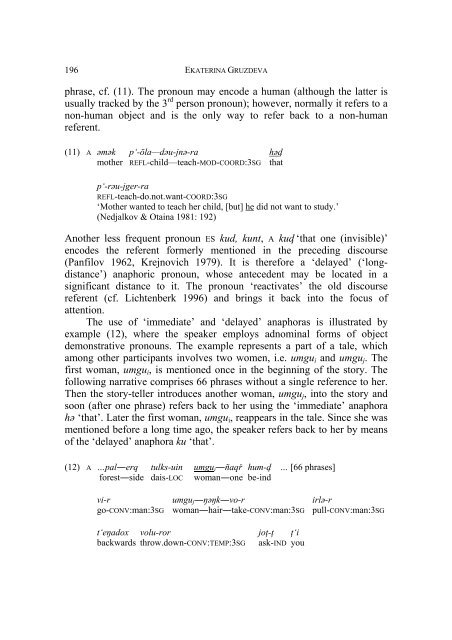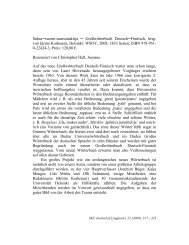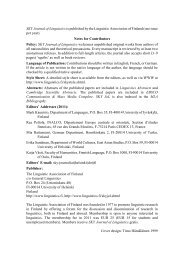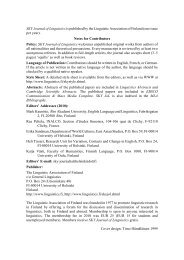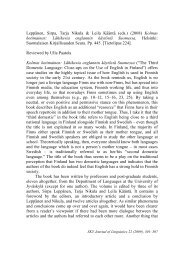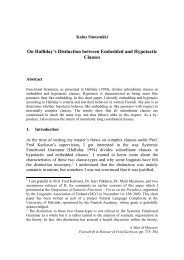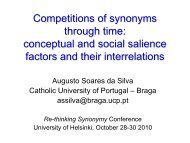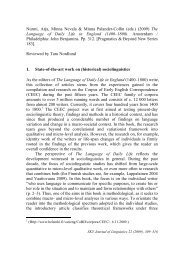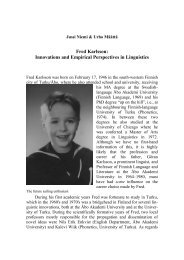'How Far from Origo?' or What the Distance Means for Nivkh ...
'How Far from Origo?' or What the Distance Means for Nivkh ...
'How Far from Origo?' or What the Distance Means for Nivkh ...
Create successful ePaper yourself
Turn your PDF publications into a flip-book with our unique Google optimized e-Paper software.
196<br />
EKATERINA GRUZDEVA<br />
phrase, cf. (11). The pronoun may encode a human (although <strong>the</strong> latter is<br />
usually tracked by <strong>the</strong> 3 rd person pronoun); however, n<strong>or</strong>mally it refers to a<br />
non-human object and is <strong>the</strong> only way to refer back to a non-human<br />
referent.<br />
(11) A əmək p‘-ōla—dəu-jnə-ra həd<br />
mo<strong>the</strong>r REFL-child—teach-MOD-COORD:3SG that<br />
p‘-rəu-jger-ra<br />
REFL-teach-do.not.want-COORD:3SG<br />
‘Mo<strong>the</strong>r wanted to teach her child, [but] he did not want to study.’<br />
(Nedjalkov & Otaina 1981: 192)<br />
Ano<strong>the</strong>r less frequent pronoun ES kud, kunt, A kud ‘that one (invisible)’<br />
encodes <strong>the</strong> referent f<strong>or</strong>merly mentioned in <strong>the</strong> preceding discourse<br />
(Panfilov 1962, Krejnovich 1979). It is <strong>the</strong>ref<strong>or</strong>e a ‘delayed’ (‘longdistance’)<br />
anaph<strong>or</strong>ic pronoun, whose antecedent may be located in a<br />
significant distance to it. The pronoun ‘reactivates’ <strong>the</strong> old discourse<br />
referent (cf. Lichtenberk 1996) and brings it back into <strong>the</strong> focus of<br />
attention.<br />
The use of ‘immediate’ and ‘delayed’ anaph<strong>or</strong>as is illustrated by<br />
example (12), where <strong>the</strong> speaker employs adnominal f<strong>or</strong>ms of object<br />
demonstrative pronouns. The example represents a part of a tale, which<br />
among o<strong>the</strong>r participants involves two women, i.e. umgui and umguj. The<br />
first woman, umgui, is mentioned once in <strong>the</strong> beginning of <strong>the</strong> st<strong>or</strong>y. The<br />
following narrative comprises 66 phrases without a single reference to her.<br />
Then <strong>the</strong> st<strong>or</strong>y-teller introduces ano<strong>the</strong>r woman, umguj, into <strong>the</strong> st<strong>or</strong>y and<br />
soon (after one phrase) refers back to her using <strong>the</strong> ‘immediate’ anaph<strong>or</strong>a<br />
hə ‘that’. Later <strong>the</strong> first woman, umgui, reappears in <strong>the</strong> tale. Since she was<br />
mentioned bef<strong>or</strong>e a long time ago, <strong>the</strong> speaker refers back to her by means<br />
of <strong>the</strong> ‘delayed’ anaph<strong>or</strong>a ku ‘that’.<br />
(12) A …pal―erq tulks-uin umgui―ñaqř hum- d … [66 phrases]<br />
f<strong>or</strong>est―side dais-LOC woman―one be-ind<br />
vi-r umguj―ŋəŋk―vo-r irlə-r<br />
go-CONV:man:3SG woman―hair―take-CONV:man:3SG pull-CONV:man:3SG<br />
t‘eŋadox volu-r<strong>or</strong> joţ-ţ ţ‘i<br />
backwards throw.down-CONV:TEMP:3SG ask-IND you


